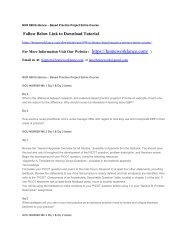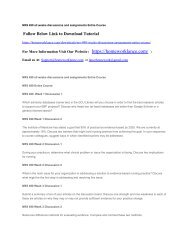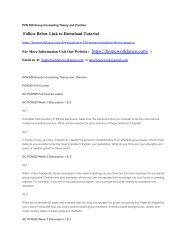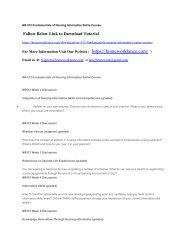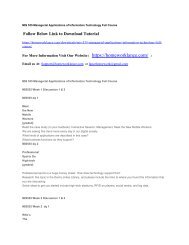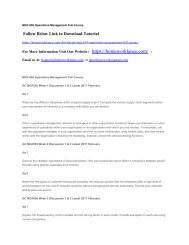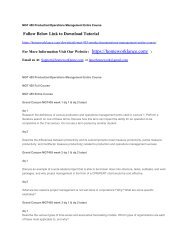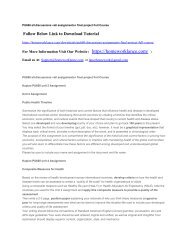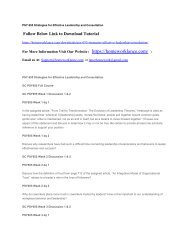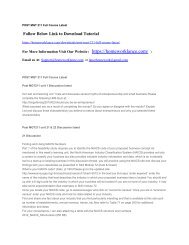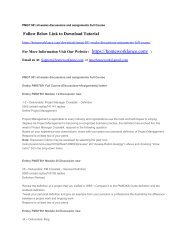NRS410 full course all assignments & all discussions
Create successful ePaper yourself
Turn your PDF publications into a flip-book with our unique Google optimized e-Paper software.
<strong>NRS410</strong> <strong>full</strong> <strong>course</strong> <strong>all</strong> <strong>assignments</strong> & <strong>all</strong> <strong>discussions</strong><br />
Follow Below Link to Download Tutorial<br />
https://homeworklance.com/downloads/nrs410-<strong>full</strong>-<strong>course</strong>-<strong>assignments</strong>-<strong>discussions</strong>/<br />
For More Information Visit Our Website ( https://homeworklance.com/ )<br />
Email us At: Support@homeworklance.com or lancehomework@gmail.com<br />
<strong>NRS410</strong> <strong>full</strong> <strong>course</strong> <strong>all</strong> <strong>assignments</strong> & <strong>all</strong> <strong>discussions</strong><br />
NRS-410V Pathophysiology and Nursing<br />
<strong>NRS410</strong> WEEK 1 DISCUSSION<br />
Max Points: 20.0<br />
The case scenario provided will be used to answer the discussion questions that follow.<br />
Case Scenario<br />
Ms. G., a 23-year-old diabetic, is admitted to the hospital with a cellulitis of her left lower leg. She has been applying<br />
heating pads to the leg for the last 48 hours, but the leg has become more painful and she has developed chilling.<br />
Subjective Data<br />
<br />
Complains of pain and heaviness in her leg.<br />
<br />
States she cannot bear weight on her leg and has been in bed for 3 days.<br />
<br />
Lives alone and has not had anyone to help her with meals.<br />
Objective Data<br />
<br />
Round, yellow-red, 2 cm diameter, 1 cm deep, open wound above medial m<strong>all</strong>eolus with moderate amount<br />
of thick yellow drainage<br />
<br />
Left leg red from knee to ankle<br />
<br />
Calf measurement on left 3 in > than right<br />
<br />
Temperature: 38.9 degrees C<br />
<br />
Height: 160 cm; Weight: 83.7 kg<br />
Laboratory Results<br />
<br />
WBC 18.3 x 10¹² / L; 80% neutrophils, 12% bands<br />
<br />
Wound culture: Staphylococcus aureus<br />
Critical Thinking Questions<br />
1. 1. What clinical manifestations are present in Ms. G and what recommendations would you make for<br />
continued treatment? Provide rationale for your recommendations.<br />
2. 2. Identify the muscle groups likely to be affected by Ms. G’s condition by referring to “ARC: Anatomy<br />
Resource Center.”<br />
3. 3. What is the significance of the subjective and objective data provided with regard to follow-up<br />
diagnostic/laboratory testing, education, and future preventative care? Provide rationale for your answer.<br />
4. 4. What factors are present in this situation that could delay wound healing, and what precautions are<br />
required to prevent delayed wound healing? Explain.
<strong>NRS410</strong> WEEK 2 DISCUSSION<br />
The American Cancer Society (ACS) is a nationwide, community-based, voluntary health organization dedicated to<br />
eliminating cancer as a major health problem. Together with its supporters, ACS is committed to helping people stay<br />
well and get well by finding cures and by fighting back.Critical Thinking Questions:<br />
1. 1. Imagine that a family friend or colleague has just been diagnosed with cancer. Explain how the American<br />
Cancer Society might provide education and support. What ACS services would you recommend and why?<br />
2. 2. According to statistics published by the American Cancer Society, there will be an estimated 1.5 million<br />
new cancer cases diagnosed each year over the next decade. What factors contribute to the yearly incidence and<br />
mortality rates of various cancers in Americans? What changes in policy and practice are most likely to affect these<br />
figures over time<br />
3. 3. Select a research program from among those funded by the American Cancer Society. Describe the<br />
program and discuss what impact the research will have on the prevention or treatment of cancer.<br />
GC <strong>NRS410</strong> WEEK 3 DISCUSSION<br />
Use the following Case Scenario, Subjective Data, and Objective Data to answer the Critical Thinking Questions.<br />
Case Scenario<br />
Mrs. J. is a 63-year-old woman who has a history of hypertension, chronic heart failure, and sleep apnea. She has<br />
been smoking two packs of cigarettes a day for 40 years and has refused to quit. Three days ago, she had an onset<br />
of flu with fever, pharyngitis, and malaise. She has not taken her antihypertensive medications or her medications to<br />
control her heart failure for 4 days. Today, she has been admitted to the hospital ICU with acute decompensated<br />
heart failure.<br />
Subjective Data<br />
1. 1. Is very anxious and asks whether she is going to die.<br />
2. 2. Denies pain but says she feels like she cannot get enough air.<br />
3. 3. Says her heart feels like it is “running away.”<br />
4. 4. Reports that she is so exhausted she cannot eat or drink by herself.<br />
Objective Data<br />
1. 1. Height 175 cm; Weight 95.5 kg<br />
2. 2. Vital signs: T 37.6 C, HR 118 and irregular, RR 34, BP 90/58<br />
3. 3. Cardiovascular: Distant S1, S2, S3, S4 present; PMI at sixth ICS and faint; <strong>all</strong> peripheral pulses are 1+;<br />
bilateral jugular vein distention; initial cardiac monitoring indicates a ventricular rate of 132 and atrial fibrillation<br />
4. 4. Respiratory: Pulmonary crackles; decreased breath sounds right lower lobe; coughing frothy blood-tinged<br />
sputum; SpO2 82%<br />
5. 5. Gastrointestinal: BS present: hepatomegaly 4 cm below costal margin<br />
Critical Thinking Questions<br />
What nursing interventions are appropriate for Mrs. J. at the time of her admission? Drug therapy is started for Mrs. J.<br />
to control her symptoms. What is the rationale for the administration of each of the following medications?<br />
1. 1. IV furosemide (Lasix)<br />
2. 2. Enalapril (Vasotec)<br />
3. 3. Metoprolol (Lopressor)<br />
4. 4. IV morphine sulphate (Morphine)<br />
Describe four cardiovascular conditions that may lead to heart failure and what can be done in the form of<br />
medical/nursing interventions to prevent the development of heart failure in each condition.
Taking into consideration the fact that most mature adults take at least six prescription medications, discuss four<br />
nursing interventions that can help prevent problems caused by multiple drug interactions in older patients. Provide<br />
rationale for each of the interventions you recommend.<br />
<strong>NRS410</strong> WEEK 4 DISCUSSION<br />
Max Points: 20.0<br />
Use the image in “Discussion Question Resource: Chest X-Ray” to answer the following Critical Thinking Questions.<br />
Examine the x-ray of a patient diagnosed with pneumonia due to infection with Mucor. Refer to the “Module 4 DQ<br />
Chest Xray” resource in order to complete the following questions.<br />
Critical Thinking Questions<br />
1. 1. Explain what Mucor is and how a patient is likely to become infected with Mucor. Describe the<br />
pathophysiologic progression of the infection into pneumonia and at least two medical/nursing interventions that<br />
would be helpful in treating the patient.<br />
2. 2. Examine the laboratory blood test results and arterial blood gases provided in “Discussion Question<br />
Resource: Laboratory Blood Test Results.” What laboratory values are considered abnormal? Explain each<br />
abnormality and discuss the probable causes from a pathophysiologic perspective.<br />
3. 3. What medications and medical treatments are likely to be prescribed by the attending physician on this<br />
case? List at least three medications and three treatments. Provide rationale for each of the medications and<br />
treatments you suggest.<br />
<strong>NRS410</strong> WEEK 5 DISCUSSION<br />
Max Points: 20.0<br />
The case scenario provided will be used to answer the discussion questions that follow.<br />
Case Scenario<br />
Mr. C., a 32-year-old single man, is seeking information at the outpatient center regarding possible bariatric surgery<br />
for his obesity. He reports that he has always been heavy, even as a sm<strong>all</strong> child, but he has gained about 100<br />
pounds in the last 2–3 years. Previous medical evaluations have not indicated any metabolic diseases, but he says<br />
he has high blood pressure, which he tries to control with sodium restriction and sleep apnea. He current works at a<br />
catalog telephone center.<br />
Objective Data<br />
<br />
Height: 68 inches; Weight 134.5 kg<br />
BP: 172/96, HR 88, RR 26<br />
<br />
Fasting Blood Glucose: 146/mg/dL<br />
<br />
Total Cholesterol: 250mg/dL<br />
<br />
Triglycerides: 312 mg/dL<br />
<br />
HDL: 30 mg/dL<br />
Critical Thinking Questions<br />
1. What health risks associated with obesity does Mr. C. have? Is bariatric surgery an appropriate intervention?<br />
Why or why not?<br />
2. Mr. C. has been diagnosed with peptic ulcer disease and the following medications have been ordered: (a)<br />
Magnesium hydroxide/aluminum hydroxide (Mylanta) 15 mL PO 1 hour before bedtime and 3 hours after mealtime<br />
and at bedtime; (b) Ranitidine (Zantac) 300 mg PO at bedtime; and (c) Sucralfate / Carafate 1 g or 10ml suspension<br />
(500mg / 5mL) 1 hour before meals and at bedtime.
The patient reports eating meals at 7 a.m., noon, and 6 p.m., and a bedtime snack at 10 p.m. Plan an administration<br />
schedule that will be most therapeutic and acceptable to the patient.<br />
1. Assess each of Mr. C.’s functional health patterns using the information given (Hint: Functional health<br />
patterns include health-perception – health management, nutritional – metabolic, elimination, activity-exercise, sleeprest,<br />
cognitive-perceptual, self-perception – self-concept, role-relationship, sexuality – reproductive, coping – stress<br />
tolerance).<br />
2. What actual or potential problems can you identify? Describe at least five problems and provide the rationale<br />
for each.<br />
GC <strong>NRS410</strong> WEEK 2 ASSIGNMENT<br />
Details:<br />
Write a paper (1,250-1,750 words) describing the approach to care of cancer. In addition, include the following in your<br />
paper:<br />
1. 1. Describe the diagnosis and staging of cancer.<br />
2. 2. Describe at least three complications of cancer, the side effects of treatment, and methods to lessen<br />
physical and psychological effects.<br />
3. 3. Prepare this assignment according to the APA guidelines found in the APA Style Guide, located in the<br />
Student Success Center. An abstract is not required.<br />
This assignment uses a grading rubric. Instructors will be using the<br />
rubric to grade the assignment; therefore, students should review the rubric prior to beginning the assignment to<br />
become familiar with the assignment criteria and expectations for successful completion of the assignment.<br />
You are required to submit this assignment to Turnitin. Refer to the directions in the Student Success Center. Only<br />
Word documents can be submitted to Turnitin.<br />
<strong>NRS410</strong> WEEK 3 CASE STUDY 1<br />
Details:<br />
In a short essay (500-750 words), answer the Question at the end of Case Study 1. Cite references to support your<br />
positions.<br />
Prepare this assignment according to the APA guidelines found in the APA Style Guide, located in the Student<br />
Success Center. An abstract is not required.<br />
This assignment uses a grading rubric. Instructors will be using the rubric to grade the assignment; therefore,<br />
students should review the rubric prior to beginning the assignment to become familiar with the assignment criteria<br />
and expectations for successful completion of the assignment.<br />
You are required to submit this assignment to Turnitin.<br />
Case Study 1<br />
Case Study 1<br />
Ms. A. is an apparently healthy 26-year-old white woman. Since the beginning of the current golf season, Ms. A has<br />
noted increased shortness of breath and low levels of energy and enthusiasm. These symptoms seem worse during<br />
her menses. Today, while playing in a golf tournament at a high, mountainous <strong>course</strong>, she became light-headed and<br />
was taken by her golfing partner to the emergency clinic. The attending physician’s notes indicated a temperature of<br />
98 degrees F, an elevated heart rate and respiratory rate, and low blood pressure. Ms. A states, “Menorrhagia and<br />
dysmenorrheal have been a problem for 10-12 years, and I take 1,000 mg of aspirin every 3 to 4 hours for 6 days<br />
during menstruation.” During the summer months, while playing golf, she also takes aspirin to avoid “stiffness in my<br />
joints.”
Laboratory values are as follows:<br />
Hemoglobin = 8 g/dl<br />
Hematocrit = 32%<br />
Erythrocyte count = 3.1 x 10/mm<br />
RBC smear showed microcytic and hypochromic cells<br />
Reticulocyte count = 1.5%<br />
Other laboratory values were within normal limits.<br />
Question<br />
Considering the circumstances and the preliminary workup, what type of anemia does Ms. A most likely have? In an<br />
essay of 500-750 words, explain your answer and include rationale.<br />
<strong>NRS410</strong> WEEK 3 CASE STUDY 2<br />
<br />
<br />
<br />
<br />
Details:<br />
In a short essay (500-750 words), answer the Question at the end of Case Study 2. Cite references to support your<br />
positions.<br />
Prepare this assignment according to the APA guidelines found in the APA Style Guide, located in the Student<br />
Success Center. An abstract is not required.<br />
This assignment uses a grading rubric. Instructors will be using the rubric to grade the assignment; therefore,<br />
students should review the rubric prior to beginning the assignment to become familiar with the assignment criteria<br />
and expectations for successful completion of the assignment.<br />
You are required to submit this assignment to Turnitin.<br />
Case Study 2<br />
Case Study 2<br />
Mr. P is a 76-year-old male with cardiomyopathy and congestive heart failure who has been hospitalized frequently to<br />
treat CHF symptoms. He has difficulty maintaining diet restrictions and managing his polypharmacy. He has 4+ pitting<br />
edema, moist crackles throughout lung fields, and labored breathing. He has no family other than his wife, who<br />
verbalizes sadness over his declining health and over her inability to get out of the house. She is overwhelmed with<br />
the stack of medical bills, as Mr. P always took care of the financial issues. Mr. P is despondent and asks why God<br />
has not taken him.<br />
Question<br />
Considering Mr. P’s condition and circumstance, write an essay of 500-750 words that includes the following:<br />
Describe your approach to care.<br />
Recommend a treatment plan.<br />
Describe a method for providing both the patient and family with education and explain your rationale.<br />
Provide a teaching plan (avoid using terminology that the patient and family may not understand).<br />
<strong>NRS410</strong> WEEK 4 assignment<br />
Details:<br />
This is a CLC assignment.<br />
As a group, observe the simulated “Home Visit With S<strong>all</strong>ie Mae Fisher” video<br />
(.gcumedia.com/zwebassets/<strong>course</strong>MaterialPages/nrs410v_vp01Alt.php”<br />
title=”http://lc.gcumedia.com/zwebassets/<strong>course</strong>MaterialPages/nrs410v_vp01Alt.php”>http://lc.gcumedia.com/zwebas<br />
sets/<strong>course</strong>MaterialPages/nrs410v_vp01Alt.php).
Refer to “S<strong>all</strong>ie Mae Fisher’s Health History and Discharge Orders” for specifics related to the case study used to<br />
inform the assignment.<br />
Using “Home Visit With S<strong>all</strong>ie Mae Fisher” and “S<strong>all</strong>ie Mae Fisher’s Health History and Discharge Orders,” complete<br />
the following components of this assignment:<br />
Essay Portion<br />
After viewing the home visit, write an essay of 500-750-words in which you do the following:<br />
1. 1. Identify, prioritize, and describe at least four problems.<br />
2. 2. Provide substantiating evidence (assessment data) for each problem identified.<br />
3. 3. Identify and describe at least four medical and/or nursing interventions.<br />
4. 4. Discuss your rationale for the interventions identified.<br />
Prepare this step of the assignment according to the APA guidelines found in the APA Style Guide, located in the<br />
Student Success Center. An abstract is not required.<br />
Scripted Dialogue Portion<br />
Utilizing the information learned from the home visit, health histories, and discharge orders, write a scripted dialogue<br />
in which you provide S<strong>all</strong>ie Mae with education that describes her problems and the interventions identified to<br />
improve her condition. Consider S<strong>all</strong>ie Mae’s physiological, psychosocial, educational, and spiritual needs when<br />
developing your dialogue.<br />
Your dialogue should resemble a script. The following is an ex<strong>amp</strong>le of a few sentences from a scripted dialogue:<br />
Nurse: “Good morning, S<strong>all</strong>e Mae, my name is ______ and I will be your nurse today. I understand you are<br />
experiencing problems with ________.”<br />
APA format is not required for this part of the assignment, but solid academic writing is expected.<br />
Refer to “Home Visit With S<strong>all</strong>ie Mae Fisher Grading Criteria.”<br />
Entire Assignment<br />
You are required to submit this assignment to Turnitin. Refer to the directions in the Student Success Center. Only<br />
Word documents can be submitted to Turnitin.<br />
S<strong>all</strong>ie Mae Fisher’s Health History<br />
and Discharge Orders<br />
S<strong>all</strong>ie Mae Fisher Health History<br />
Ms. Fisher is an 82-year-old female with a history of chronic congestive heart failure (CHF), atrial fibrillation, and<br />
hypertension. During the last 6 months, she has been hospitalized four times for exacerbation of her CHF. She was<br />
discharged home last Saturday from the hospital after a 3-day stay to treat increased dyspnea, an 8-pound weight<br />
gain, and chest pain.<br />
Ms. Fisher is recently widowed and lives alone. She has a daughter, Thelma Jean, who lives in town but works <strong>full</strong><br />
time and has family issues of her own. Therefore, family support is limited.<br />
Hospital Discharge Instructions<br />
<br />
Mountain Top Home Health to evaluate cardio-pulmonary status, medication management, and home<br />
safety.<br />
<br />
Medical Equipment Company to deliver oxygen concentrator and instruct patient in use. O 2 at 2 liters per<br />
nasal prongs PRN.<br />
<br />
Prescriptions given at discharge:<br />
o Digoxin 0.25 mg once a day<br />
o Lasix 80 mg twice a day<br />
o Calan 240 mg once a day<br />
<br />
Order written to continue other home meds.<br />
S<strong>all</strong>ie Mae’s Home Medication List<br />
<br />
Zocar 50 mg once a day<br />
<br />
Minipres 1 mg once a day<br />
<br />
Vasotec 10 mg twice a day
Prilosec 20 mg once a day<br />
Furosemide 40 mg once a day<br />
Effexor 37.5 mg at bedtime<br />
Lanoxin 0.125 mg every other day<br />
Multivitamin once a day<br />
Potassium 40 mEq once a day<br />
Ibuprofen 400 mg q 4 hours as needed for pain<br />
Darvocet N 100 mg q 4 hours as needed for pain<br />
Nitroglycerin ointment, apply 1 inch every day<br />
GC <strong>NRS410</strong> WEEK 5 assignment<br />
Details:<br />
Identify a research or evidence-based article that focuses comprehensively on a specific intervention or new<br />
diagnostic tool for the treatment of diabetes in adults or children.<br />
In a paper of 750-1,000 words, summarize the main idea of the research findings for a specific patient population.<br />
Research must include clinical findings that are current, thorough, and relevant to diabetes and the nursing practice.<br />
Prepare this assignment according to the APA guidelines found in the APA Style Guide, located in the Student<br />
Success Center. An abstract is not required.<br />
This assignment uses a grading rubric. Instructors will be using the rubric to grade the assignment; therefore,<br />
students should review the rubric prior to beginning the assignment to become familiar with the assignment criteria<br />
and expectations for successful completion of the assignment.<br />
You are required to submit this assignment to Turnitin. Refer to the directions in the Student Success Center. Only<br />
Word documents can be submitted to Turnitin.<br />
Details:<br />
Based on the summary of research findings identified from the Evidence-Based Project—Paper on Diabetes that<br />
describes a new diagnostic tool or intervention for the treatment of diabetes in adults or children, complete the<br />
following components of this assignment:<br />
Develop a PowerPoint presentation (a title slide, 6-12 slides, and a reference slide; no larger than 2 MB) that includes<br />
the following:<br />
1. 1. A brief summary of the research conducted in the Evidence-Based Project – Paper on Diabetes.<br />
2. 2. A descriptive and reflective discussion of how the new tool or intervention may be integrated into practice<br />
that is supported by sound research.<br />
While APA format is not required for the body of this assignment, solid academic writing is expected, and in-text<br />
citations and references should be presented using APA documentation guidelines, which can be found in the APA<br />
Style Guide, located in the Student Success Center.<br />
You are not required to submit this assignment to Turnitin, unless otherwise directed by your instructor. If so directed,<br />
refer to the Student Success Center for directions. Only Word documents can be submitted to Turnitin.



